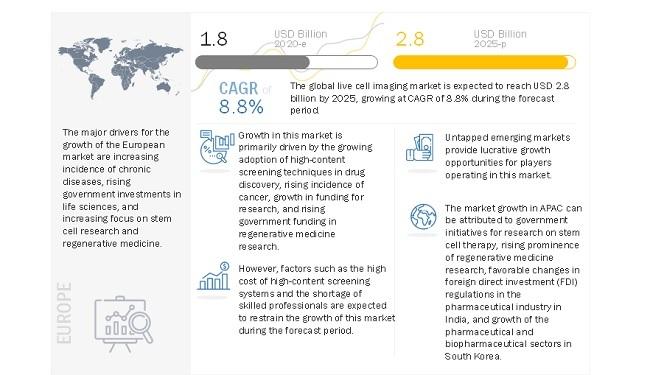
The growth in research funding and rising government funding and investment in regenerative medicine research will also support the market growth in the coming years. However, the high cost of high-content screening systems is limiting the overall adoption of these products.
The global live cell imaging market size is expected to reach USD 2.8 billion by 2025 from an estimated value of USD 1.8 billion in 2020, growing at a CAGR of 8.8% during the forecast period. growing adoption of high-content screening techniques in drug discovery and rising incidence of cancer primarily drives the market for live cell imaging.
Covid-19 Impact on the Live Cell Imaging Market
The COVID-19 pandemic has resulted in a tremendous increase in the burden on healthcare organizations across the globe. According to the WHO, as of September 29, 2020, there were 33,249,563 confirmed cases of COVID-19, including 1,000,040 deaths, with the highest number of deaths in the Americas, followed by Europe and Southeast Asia.

Currently, no effective treatment for COVID-19 is available in the form of vaccines or antiviral drugs, and patients are currently treated symptomatically. According to the WHO, there are 70 vaccine candidates under development, and three candidates are already being tested in human trials. At the forefront of the COVID-19 outbreak, many researchers worldwide are engaged in the viral research of SARS-CoV-2, the virus that causes COVID-19.
For More Information Download PDF Brochure @ https://www.marketsandmarkets.com/pdfdownloadNew.asp?id=163914483
To overcome these challenges, pharmaceutical companies are increasingly adopting high-content screening (HCS) cell-based assays for identifying the effects of toxicity in drug development studies (cell-based imaging enables the monitoring of drug toxicity mechanisms, such as oxidative stress, micronuclei, mitochondrial dysfunction, steatosis, and apoptosis).
The use of HCS makes the drug development process more time- and cost-efficient. Owing to these factors, the adoption of high-content screening for toxicity studies is expected to increase during the forecast period. This, in turn, is expected to drive market growth as live cell imaging is used in HCS to identify meaningful information from complex systems such as in vitro, in vivo, and ex vivo systems.
High-content screening (HCS) instruments are equipped with advanced features and functionalities and are, therefore, priced at a premium. A confocal microscope, for instance, can cost more than USD 250,000, and a wide-field microscope can cost more than USD 100,000.
The high price of these instruments is also a concern for several pharmaceutical companies as they require multiple HCS systems in their R&D activities (thus increasing the total cost spent on these systems). In addition to the high procurement costs, the maintenance costs and several other indirect expenses increase the total cost of ownership of these instruments.
The high growth rate of this region can mainly be attributed to the factors such as the government initiatives for research on stem cell therapy, the rising prominence of regenerative medicine research, growth of preclinical/clinical research in China, favorable changes in foreign direct investment (FDI) regulations in the pharmaceutical industry in India, and growth of the pharmaceutical and biopharmaceutical sectors in South Korea.




























